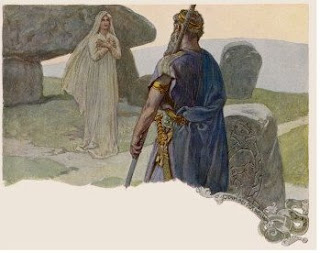Magic (galdur or galdrar) could be good or bad and implemented through the use of galdrastafir (sigils, symbols), runes, or through words. Spells were very elaborate and well thought out. For instance, you could get a ghost under your power with a spell that caused a corpse to rise from its grave. As it did so, you had to reach down and strangle it until it asked you to stop. At that point you had a ghost under your control. You had to ask it its age, however, and if it were older than 14 or 15, you had to send it back to its grave, because a ghost older than that could be too powerful to keep under your control.*
Tales of galdrar are usually about human practitioners. Iceland is full of tales and beliefs about non-human beings. There are two terms for most of them: the older álfar (elf people) and the later term huldufólk (hidden people). These beings inhabit the land (largely) invisibly, but their dwellings (among rocks) and their well-traveled paths are known. Disturbing their homes is a grave offense, and they will seek revenge. Modern-day Iceland will alter construction projects to avoid damaging rocks or cliffs lest the hidden folk be offended.
South of Reykjavik, in the town of Kopavogur, there is an elf hill, Álfhóll, a quite small area with some large boulders that is in an ideal spot to put a road through. Three attempts to build a road have failed.
The first effort was abandoned when funding ran out just before blasting could begin. A decade later, a second attempt was thwarted when heavy equipment and machinery repeatedly broke down without explanation. In the 1990s, a third attempt was made to remove part of the hill for road repairs, but powerful drills broke apart without even leaving a mark on the rock! [link]
Álfhóll is now considered a protected site, and the road squeezes around it.
Interactions between humans and álfar could be pleasant. The illustration is of an altar cloth in the National Museum of Iceland. This cloth was supposedly given to a human woman by an elf woman who was grateful for assistance in childbirth. It is unique as an artifact related to elf folklore.
Let's expand our look at elf people to the rest of Europe tomorrow.
*Some of what I'm sharing is from a TV series called Supernatural Iceland.












